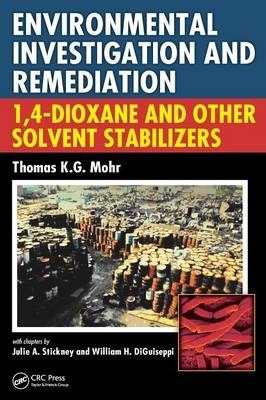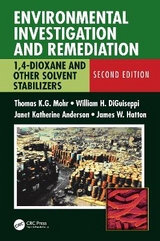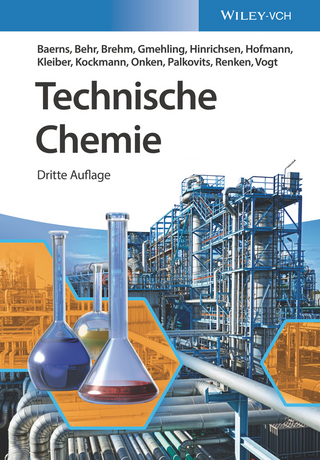
Environmental Investigation and Remediation
Crc Press Inc (Verlag)
978-1-56670-662-9 (ISBN)
- Titel erscheint in neuer Auflage
- Artikel merken
A ubiquitous, largely overlooked groundwater contaminant, 1,4-dioxane escaped notice by almost everyone until the late 1990s. While some dismissed 1,4-dioxane because it was not regulated, others were concerned and required testing and remediation at sites they oversaw. Drawing years of 1,4-dioxane research into a convenient resource, Environmental Investigation and Remediation: 1,4-Dioxane and other Solvent Stabilizers profiles the nature of 1,4-dioxane and several dozen other solvent stabilizer compounds.
The author takes an approach he calls "contaminant archeology", i.e., reviewing the history of the contaminating chemical’s use in the industrial workplace at the site of release and how those uses impart chemical characteristics to the waste that affects its fate and transport properties. The book examines the uses, environmental fate, laboratory analysis, toxicology, risk assessment, and treatment of 1,4-dioxane in extensive detail. It provides case studies that document the contaminant migration, regulation, treatment, and legal aspects of 1,4-dioxane releases. It also describes the controversy over interpretation of 1,4-dioxane’s toxicology and associated risk, as well as the corresponding disparity in states’ regulation of 1,4-dioxane. A final chapter examines the policy implications of emerging contaminants like 1,4-dioxane, with discussion of opportunities to improve the regulatory and remedial response to this persistent contaminant in the face of toxicological uncertainty.
Mobility, persistence, and treatment challenges combine to make 1,4-dioxane a particularly vexing contaminant. It is more mobile than any other contaminant you are likely to find at solvent release sites. Filled with case studies, equations, tables, figures, and citations, the book supplies a wide range of information on 1,4-dioxane. It then provides passive and active remediation strategies and treatment technologies for 1,4-dioxane in groundwater and provides you with the technical resources to help you decide which are appropriate for your site.
For more information about Thomase Mohr and his book, go to http://www.The14DioxaneBook.com
Santa Clara Valley Water District, San Jose, California, USA SRC, Inc., Syracuse, New York, USA AECOM, Greenwood Village, Colorado, USA
Historical Use of Chlorinated Solvents and Their Stabilizing Compounds
History of Chlorinated Solvents
Role of Solvent Stabilizers
Acknowledgments
Bibliography
1,4-Dioxane: Chemistry, Uses, and Occurrence
Chemistry of 1,4-Dioxane
History of 1,4-Dioxane Production
Direct Uses of 1,4-Dioxane
1,4-Dioxane as a By-Product of Manufacturing
1,4-Dioxane in Food
Detections of 1,4-Dioxane in Ambient Surface Water, Groundwater, and Air
Estimated Releases of 1,4-Dioxane to the Environment
Environmental Fate and Transport of Solvent-Stabilizer Compounds
Fate and Transport Processes
Surface-Water Fate and Transport Processes
Subsurface Fate and Transport Processes
Laboratory, Field, and Modeling Studies of 1,4-Dioxane Mobility
Diffusive Transport of 1,4-Dioxane and Storage in Fine-Grained Soils
Bibliography
Sampling and Laboratory Analysis for Solvent Stabilizers
The Flawed Paradigm of Analyte Lists
Sample Collection, Preservation, and Handling for Analysis of 1,4-Dioxane
Sample Preparation
Laboratory Methods for the Analysis of 1,4-Dioxane by GC–MS
Environmental Protection Agency Methods for Analysis of 1,4-Dioxane
Laboratory Safety for 1,4-Dioxane Handling and Instrument Cleaning
Acknowledgments
Bibliography
The Toxicology of 1,4-Dioxane
Toxicokinetics
Toxicity Studies in Humans
Toxicology Studies in Laboratory Animals
Summary of Noncancer Health Effects
Characterization of Cancer Potential
Acknowledgments
Bibliography
Regulation and Risk Assessment of 1,4-Dioxane
Drinking Water Regulations for 1,4-Dioxane
Water Quality Regulations: Protection of Ecological Receptors
Air Quality Regulations: Occupational Health and Safety and Ambient Air Quality
Regulating 1,4-Dioxane in Food, Pharmaceuticals, Cosmetics, and Sundries
Risk Assessments of 1,4-Dioxane
Acknowledgment
Bibliography
Remediation Technologies
Vapor-Phase Transfer
Sorption
Natural Attenuation
Ultraviolet Photolysis
Phytoremediation
Bioremediation
Chemical Oxidation
Bibliography
Case Studies of 1,4-Dioxane Releases, Treatment, and Drinking Water Contamination
Superfund Site at Seymour, Indiana
Solvent Services Site, San Jose, California
Pall/Gelman Sciences Inc., Ann Arbor, Michigan
Former American Beryllium Company, Tallevast, Florida
Stanford Linear Accelerator Center Groundwater Cleanup Sites
1,4-Dioxane and Orange County Water District (OWCD)’s Groundwater Replenishment System
Air Force Plant 44, Tucson, Arizona
Acknowledgments
Bibliography
Forensic Applications for 1,4-Dioxane and Solvent Stabilizers
Leveraging 1,4-Dioxane Data for Plume Analysis and Source Apportionment
Ratio Analysis
Solvent Stabilizers as Age Markers
Solvent Stabilizers as Markers of Solvent Applications
Bibliography
Regulatory Policy Implications of 1,4-Dioxane
Applying the Precautionary Principle to Regulation of 1,4-Dioxane and Emerging Contaminants in Drinking Water
Updating the toxicological basis for 1,4-dioxane regulation
Regulatory Policy on 1,4-Dioxane Remediation at Cleanup Sites
Blindsided Again?
The promise of Green Chemistry
Should 1,4-dioxane be banned?
Regulatory Policy Recommendations for Addressing 1,4-Dioxane Releases
Acknowledgments
Bibliography
Appendix 1: Synopses of Selected Patents from the Art of Solvent Stabilization
Appendix 2: Fate and Transport Properties of Solvent-Stabilizer Compounds
Appendix 3: Compilation of Instrumental Parameters in Literature Studies of 1,4-Dioxane Analyses of Various Media
Index
| Erscheint lt. Verlag | 25.3.2010 |
|---|---|
| Zusatzinfo | 96; 134 Tables, black and white; 61 Illustrations, black and white |
| Verlagsort | Bosa Roca |
| Sprache | englisch |
| Maße | 178 x 254 mm |
| Gewicht | 1202 g |
| Themenwelt | Schulbuch / Wörterbuch |
| Naturwissenschaften ► Chemie ► Technische Chemie | |
| Naturwissenschaften ► Geowissenschaften ► Hydrologie / Ozeanografie | |
| Technik ► Umwelttechnik / Biotechnologie | |
| ISBN-10 | 1-56670-662-9 / 1566706629 |
| ISBN-13 | 978-1-56670-662-9 / 9781566706629 |
| Zustand | Neuware |
| Informationen gemäß Produktsicherheitsverordnung (GPSR) | |
| Haben Sie eine Frage zum Produkt? |
aus dem Bereich



